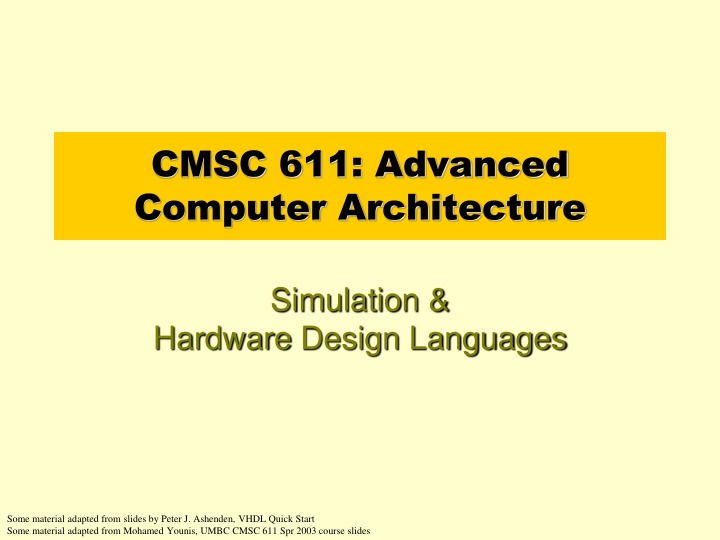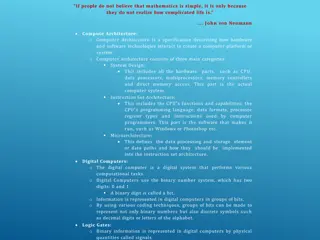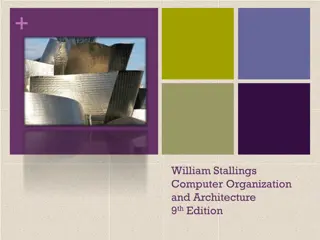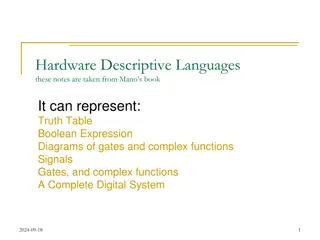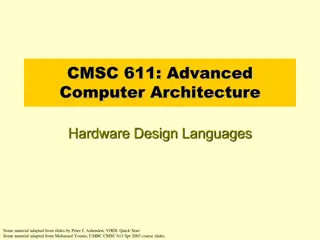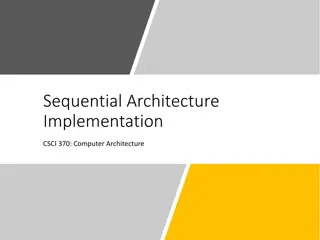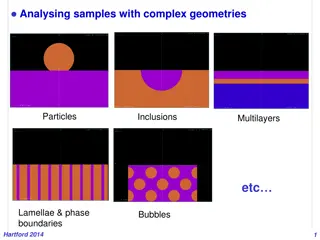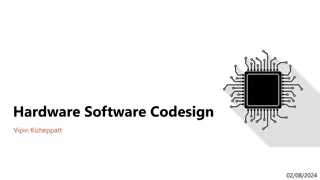Advanced Computer Architecture Simulation & Hardware Design Languages
Delve into the realms of advanced computer architecture through simulation and hardware design languages. Explore topics such as behavioral correctness, timing simulations, functional and structural modeling, geometric and algorithmic approaches, and the use of hardware design languages for behavioral description and structural verification.
Download Presentation

Please find below an Image/Link to download the presentation.
The content on the website is provided AS IS for your information and personal use only. It may not be sold, licensed, or shared on other websites without obtaining consent from the author.If you encounter any issues during the download, it is possible that the publisher has removed the file from their server.
You are allowed to download the files provided on this website for personal or commercial use, subject to the condition that they are used lawfully. All files are the property of their respective owners.
The content on the website is provided AS IS for your information and personal use only. It may not be sold, licensed, or shared on other websites without obtaining consent from the author.
E N D
Presentation Transcript
CMSC 611: Advanced Computer Architecture Simulation & Hardware Design Languages Some material adapted from slides by Peter J. Ashenden, VHDL Quick Start Some material adapted from Mohamed Younis, UMBC CMSC 611 Spr 2003 course slides
2 Behavioral Correctness Simulate behavior of system Does it work? Example: New Graphics Feature Graphics Library = Interface to HW DLL driver from hardware vendor Make a new lib simulating new feature Try in applications
3 Behavioral Timing See valgrind x86 instruction simulator Cache timing Simulate cache strategies, levels, penalties Only 2 levels, may not match HW Branch timing Simulate branch prediction strategies Success rates, penalties
Domains and Levels of Modeling 4 Functional Structural high level of abstraction low level of abstraction Geometric Y-chart due to Gajski & Kahn
5 Functional Modeling Does it do the right thing? Functional Structural Algorithm (behavioral) Register-Transfer Language Boolean Equation Differential Equation Geometric Y-chart due to Gajski & Kahn
6 Structural Modeling How does it work? Functional Structural Processor- Memory-Switch Register-Transfer Gate Transistor Geometric Y-chart due to Gajski & Kahn
7 Geometric Modeling How is it implemented? Functional Structural Polygons Sticks Standard Cells Floor Plan Geometric Y-chart due to Gajski & Kahn
8 Functional Simulator Program simulating behavior of design Match interfaces Use any language or algorithm Can use to develop external HW or SW Graphics examples SGI modified software OpenGL UNC process-per-board CPU examples SimpleScalar, Valgrind
9 Hardware Design Languages Describe behavior (with timing) C-like code with timing statements Describe structure Connections between components Verify behavior Verify that behavior & structure match Test for regression Synthesize hardware
10 VHDL & Verilog Most famous and widely used HDLs Focus on VHDL: Interfaces, Behavior, Structure, Test Benches Analysis, Elaboration, Simulation, Synthesis
11 Modeling Digital Systems VHDL is for writing models of a system Reasons for modeling requirements specification documentation testing using simulation formal verification synthesis Goal most reliable design process, with minimum cost and time avoid design errors!
12 Modeling Interfaces Entity declaration describes the input/output ports of a module entity name port names port mode (direction) entity reg4 is port ( d0, d1, d2, d3, en, clk : in bit; q0, q1, q2, q3 : out bit ); end reg4; port type
13 Modeling Behavior Architecture body describes an implementation of an entity may be several per entity Behavioral architecture describes the algorithm performed by the module contains process statements, each containing sequential statements, including signal assignment statements and wait statements
14 Behavior Example architecture behav of reg4 is begin storage : process is variable stored_d0, stored_d1, stored_d2, stored_d3 : bit; begin if en = '1' and clk = '1' then stored_d0 := d0; stored_d1 := d1; stored_d2 := d2; stored_d3 := d3; end if; q0 <= stored_d0 after 5 ns; q1 <= stored_d1 after 5 ns; q2 <= stored_d2 after 5 ns; q3 <= stored_d3 after 5 ns; wait on d0, d1, d2, d3, en, clk; end process storage; end architecture behav;
15 Modeling Structure Structural architecture implements the module as a composition of subsystems contains signal declarations, for internal interconnections the entity ports are also treated as signals component instances instances of previously declared entity/architecture pairs port maps in component instances connect signals to component ports wait statements
16 Structure Example bit0 d_latch d clk d0 q0 q bit1 d_latch d clk d1 q1 q bit2 d_latch d clk d2 q2 q bit3 d_latch d clk d3 q3 q gate and2 a b en clk int_clk y
17 Structure Example First declare D-latch and and-gate entities and architectures entity d_latch is port ( d, clk : in bit; q : out bit ); end entity d_latch; entity and2 is port ( a, b : in bit; y : out bit ); end entity and2; architecture basic of d_latch is begin latch_behavior : process is begin ifclk = 1 then q <= d after 2 ns; end if; wait on clk, d; end process latch_behavior; end architecture basic; architecture basic of and2 is begin and2_behavior : process is begin y <= a and b after 2 ns; wait on a, b; end process and2_behavior; end architecture basic;
18 Structure Example Now use them to implement a register architecture struct of reg4 is signal int_clk : bit; begin bit0 : entity work.d_latch(basic) port map ( d0, int_clk, q0 ); bit1 : entity work.d_latch(basic) port map ( d1, int_clk, q1 ); bit2 : entity work.d_latch(basic) port map ( d2, int_clk, q2 ); bit3 : entity work.d_latch(basic) port map ( d3, int_clk, q3 ); gate : entity work.and2(basic) port map ( en, clk, int_clk ); end architecture struct;
19 Mixed Behavior and Structure An architecture can contain both behavioral and structural parts process statements and component instances collectively called concurrent statements processes can read and assign to signals Example: register-transfer-level model data path described structurally control section described behaviorally
20 Mixed Example multiplier multiplicand shift_reg shift_ adder control_ section reg product
21 Mixed Example entity multiplier is port ( clk, reset : in bit; multiplicand, multiplier : in integer; product : out integer ); end entity multiplier; architecture mixed of multiplier is signal partial_product, full_product : integer; signal arith_control, result_en, mult_bit, mult_load : bit; begin arith_unit : entity work.shift_adder(behavior) port map ( addend => multiplicand, augend => full_product, sum => partial_product, add_control => arith_control ); result : entity work.reg(behavior) port map ( d => partial_product, q => full_product, en => result_en, reset => reset ); ...
22 Mixed Example multiplier_sr : entity work.shift_reg(behavior) port map ( d => multiplier, q => mult_bit, load => mult_load, clk => clk ); product <= full_product; end architecture mixed; control_section : process is -- variable declarations for control_section -- begin -- sequential statements to assign values to control signals -- wait on clk, reset; end process control_section;
23 Design Simulator Device behavioral model is represented by procedure calls Events within the simulator are kept in a time-based queue Events stored as three-tuples (Module #, Pin #, New logic value) Depending on the behavioral model of a module, the handling of an event usually trigger other events that will be inserted in the event queue Event Queue Time Simulation continues until the event queue is empty or stopped externally by the designer 0, 6, 1 - - - - - - - - - - - - - - - - - - - - - - - - - 1, 8, 0 0 - - - - - - - - - - 100 Events 100 ns Module 2 6 8 Module 0 Module 1 3 Module 3
24 Test Benches Testing a design by simulation Use a test bench model an architecture body that includes an instance of the design under test applies sequences of test values to inputs monitors values on output signals either using simulator or with a process that verifies correct operation
25 Test Bench Example entity test_bench is end entity test_bench; architecture test_reg4 of test_bench is signal d0, d1, d2, d3, en, clk, q0, q1, q2, q3 : bit; begin dut : entity work.reg4(behav) port map ( d0, d1, d2, d3, en, clk, q0, q1, q2, q3 ); stimulus : process is begin d0 <= 1 ; d1 <= 1 ; d2 <= 1 ; d3 <= 1 ; wait for 20 ns; en <= 0 ; clk <= 0 ; wait for 20 ns; en <= 1 ; wait for 20 ns; clk <= 1 ; wait for 20 ns; d0 <= 0 ; d1 <= 0 ; d2 <= 0 ; d3 <= 0 ; wait for 20 ns; en <= 0 ; wait for 20 ns; wait; end process stimulus; end architecture test_reg4;
26 Regression Testing Test that a refinement of a design is correct that lower-level structural model does the same as a behavioral model Test bench includes two instances of design under test behavioral and lower-level structural stimulates both with same inputs compares outputs for equality Need to take account of timing differences
27 Regression Test Example architecture regression of test_bench is signal d0, d1, d2, d3, en, clk : bit; signal q0a, q1a, q2a, q3a, q0b, q1b, q2b, q3b : bit; begin dut_a : entity work.reg4(struct) port map ( d0, d1, d2, d3, en, clk, q0a, q1a, q2a, q3a ); dut_b : entity work.reg4(behav) port map ( d0, d1, d2, d3, en, clk, q0b, q1b, q2b, q3b ); stimulus : process is begin d0 <= 1 ; d1 <= 1 ; d2 <= 1 ; d3 <= 1 ; wait for 20 ns; en <= 0 ; clk <= 0 ; wait for 20 ns; en <= 1 ; wait for 20 ns; clk <= 1 ; wait for 20 ns; wait; end process stimulus; ...
28 Regression Test Example verify : process is begin wait for 10 ns; assert q0a = q0b and q1a = q1b and q2a = q2b and q3a = q3b report implementations have different outputs severity error; wait on d0, d1, d2, d3, en, clk; end process verify; end architecture regression;
29 Design Processing Analysis Elaboration Simulation Synthesis
30 Analysis Check for syntax and semantic errors syntax: grammar of the language semantics: the meaning of the model Analyze each design unit separately entity declaration architecture body best if each design unit is in a separate file Analyzed design units are placed in a library in an implementation dependent internal form current library is called work
31 Elaboration Flattening the design hierarchy create ports create signals and processes within architecture body for each component instance, copy instantiated entity and architecture body repeat recursively bottom out at purely behavioral architecture bodies Final result of elaboration flat collection of signal nets and processes
32 Elaboration Example bit0 d_latch d reg4(struct) d0 q0 q clk bit1 d_latch d d1 q1 q clk bit2 d_latch d d2 q2 q clk bit3 d_latch d d3 q3 q clk gate and2 en int_clk a y clk b
33 Elaboration Example bit0 d_latch(basic) d reg4(struct) d0 q0 q clk bit1 d_latch(basic) d d1 q1 q clk bit2 d_latch(basic) d d2 q2 q clk bit3 d_latch(basic) d d3 q3 q clk gate and2(basic) a en int_clk y process with variables and statements clk b
34 Simulation Execution of the processes in the elaborated model Discrete event simulation time advances in discrete steps when signal values change events A processes is sensitive to events on input signals specified in wait statements resumes and schedules new values on output signals schedules transactions event on a signal if new value different from old value
35 Simulation Algorithm Initialization phase each signal is given its initial value simulation time set to 0 for each process activate execute until a wait statement, then suspend execution usually involves scheduling transactions on signals for later times
36 Simulation Algorithm Simulation cycle advance simulation time to time of next transaction for each transaction at this time update signal value event if new value is different from old value for each process sensitive to any of these events, or whose wait for time-out has expired resume execute until a wait statement, then suspend Simulation finishes when there are no further scheduled transactions
37 Synthesis Translates register-transfer-level (RTL) design into gate-level netlist Restrictions on coding style for RTL model Tool dependent
38 Basic Design Methodology Requirements Simulate RTL Model Synthesize Gate-level Model Simulate Test Bench ASIC or FPGA Place & Route Timing Model Simulate
